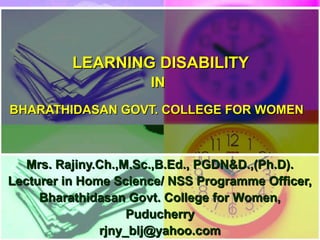
Learning Disability Study at Bharathidasan College
- 1. LEARNING DISABILITY IN BHARATHIDASAN GOVT. COLLEGE FOR WOMEN Mrs. Rajiny.Ch.,M.Sc.,B.Ed., PGDN&D.,(Ph.D). Lecturer in Home Science/ NSS Programme Officer, Bharathidasan Govt. College for Women, Puducherry rjny_blj@yahoo.com
- 2. What is Learning Disability ? The term learning disability (LD) refers to a group of disorders that affect a broad range of academic and functional skills including the ability to speak, listen, read, write, spell, reason and organize information
- 3. TYPES OF LEARNING DISABILITY Dyslexia -Difficulty with accurate and/or fluent word recognition, word decoding, reading rate, prosody (oral reading with expression), and reading comprehension. Dysphasia/Aphasia-Speech and language disorders Dysgraphia- Impaired written language ability may include impairments in handwriting&spelling Dyscalculia- Difficulties as learning math concepts (such as quantity, place value, and time), difficulty memorizing math facts, difficulty organizing numbers, and understanding how problems are organized Dyspraxia - A variety of difficulties with motor skills
- 4. A short study was conducted in Bharathidasan Govt. College for Women
- 5. OBJECTIVE OF THE STUDY To identify the type of learning disability prevalent among students of Bharathidasan Govt.College for Women. To plan measures to treat those with learning disability.
- 6. METHODOLOGY OF THE STUDY Samples were selected randomly. Fifty samples were selected Interview schedule was used as the tool
- 7. RESULTS Poor performance on group tests (28%) Difficulty discriminating size, shape, color (6%) Difficulty with temporal (time) concepts( Nil) Distorted concept of body image (Nil) Reversals in writing and reading (Nil) Poor visual-motor coordination (Nil) Hyperactivity (16%) Difficulty copying accurately from a model (10%) Slowness in completing work (20%) Poor organizational skills (26%) Easily confused by instructions (12%) Difficulty with abstract reasoning and/or problem solving (12%) Disorganized thinking (Nil) Often obsesses on one topic or idea (4%) Poor short-term or long-term memory (28%)
- 8. RESULTS Impulsive behavior; lack of reflective thought prior to action (30%) Low tolerance for frustration (8%) Excessive movement during sleep (10%) Poor peer relationships (14%) Overly excitable during group play (16%) Poor social judgment (12%) Inappropriate, unselective, and often excessive display of affection (10%) Lags in developmental milestones (e.g. motor, language) (2%) Behavior often inappropriate for situation (Nil) Failure to see consequences for his actions (12%) Overly gullible; easily led by peers (16%) Excessive variation in mood and responsiveness (10%) Poor adjustment to environmental changes (10%) Overly distractible; difficulty concentrating (20%) Difficulty making decisions (36%) Lack of hand preference or mixed dominance (16%) Difficulty with tasks requiring sequencing (22%)
- 9. Prevalence under broader classification: “Dyslexia" – 50% Dysphasia/aphasia-4% Dysgraphia -14% Dyscalculia -5% Dyspraxia –Nil
- 10. Possible reasons for prevalence of Learning Disability Fear Stress Lack of interest Compulsion Improper teaching method Tease Lack of time (hurry) Lack of practice (training) Lack of self confidence Inferiority Complex/Superiority Complex Negative attitude Weak body and mind Lack of love and care
- 11. POINTERS TO TREAT STUDENTS WITH LEARNING DISABILITIES Look for and encourage their strengths, interests, and abilities Reward them with praise, good words, smiles, as often as you can Accept them for what they are and for their human potential for growth and development Involve them in establishing rules and regulations, schedules, and family activities Tell them when they misbehave and explain how you feel about their behavior and propose a better behaviour Help them to correct their errors and mistakes by showing or demonstrating what they should do Don't nag! Give them reasonable chores and a regular work responsibility Provide games, motor activities and opportunities that will stimulate them in their development. (Contd…)
- 12. Contd………… Relate incidences of moral values to them. Encourage them to ask questions & discuss. Further improve their ability to concentrate by reducing distracting aspects of their environment Don't get hung up on traditional school grades! It is important that they progress at their own rates and be rewarded for doing so. Take them to libraries and encourage them to select and check out books of interest Help them to develop self-esteem and to compete with self rather than with others Insist that they cooperate socially by playing, helping, and serving others in the family and the community. Don't hesitate to consult with other colleagues, family members or other specialists ( Contd….)
- 13. CONCLUSION Each child is unique Learn to respect their individual identity Identify students with learning disability Provide some time and care to improve them This will help the student towards better performance
